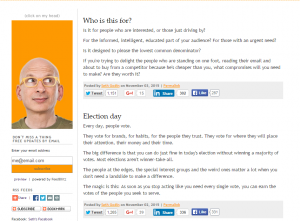What To Avoid With Content Marketing

Writing is a creative task, especially when engaging in creative writing tasks or creating a fictional novel. However, some forms of writing are serving a whole other purpose than entertainment. Information, contract sealing, instructions—and marketing. So-called content marketing is a form of connection businesses create
No matter if you are creating your own content for marketing, connecting, and information reason, or whether you are being paid to create content for someone, the mistakes and problems you face are all the same. The content you create may be good, but that is not all it takes for written content to be a competitive tool. People have to find and read your content, otherwise you are just wasting your time.
In this article, Online-Spellcheck.com will address some common mistakes that may be the reason why your content is not fairing too well:
The Title
Sometimes, the reasons why your articles or posts are not doing well does not lie in the content itself. The title or headline of the article plays a huge role in attracting people to read your content. Thus, if the headline does not entice people to read your article, all efforts you put into writing are essentially fruitless.
Headlines are the first thing your potential readers see, what pops up in a Google search, and what’s most commonly shared via social media. Thus, the title has to be interesting and attractive for your audience.
Here’s Everything You Should Know About Headlines
Length Of Content
There is no general rule of thumb as of how long your content should be. Some bloggers and SEO experts prefer longer posts since they rank way better in search engines than short articles. They provide more space for keywords and SEO as well as other important features like keyword-rich headlines.
 Does that mean posting short content is wrong? Not necessarily! For some bloggers, e.g. author Seth Godin, producing and sharing short and concise content is the key to engage their audience.
Does that mean posting short content is wrong? Not necessarily! For some bloggers, e.g. author Seth Godin, producing and sharing short and concise content is the key to engage their audience.
So, what to make of these findings? As in many cases, the answer is easy: It’s the mixture that makes the most enticing overall content. It is okay to have some shorter and some very long articles, as long as it fits the content’s subject and provides valuable information for your audience.
However, if you are striving for best exposure together with good readability, longer content than three or four sentences is the way to go. Researchers suggest that the content length you should strive for is about 1.500 words.
Spelling & Grammar Mistakes
Typos happen. It’s normal and oftentimes easily over-read when you double-check your content before publishing. However, if there is a bulk of spelling or grammar errors scattered across your text—or even in the headline—your content has close to no chance to get read let alone shared.
Even the best writers make mistakes, and some are simply hard to detect when you are familiar by the content of your writing already. Thus, having a second pair of eyes or even an editor to look over your text and proof-read it should be a must. If you can not afford or do not have the time or means to do so, online services like Online-Spellcheck.com can function as technical little helpers for you as well.
The “Wrong” Language
Something that can not be detected by a spellchecker—maybe not even by a human one—is the language you use for your articles. Poor language or using a tone that does not appeal to the target audience is a no-go just as much as the average spelling mistake.
If your audience is technically versatile, using simple language and explaining basic concepts should be omitted. On the other hand, if you are writing for an audience that needs and wants an insight into your business, step back from the tech talk and try to use easily to understand concepts to explain technical or otherwise complicated things.
Variation In Style
You, as a writer, have your own style. Just like everyone else has their own. However, always utilizing the same words, phrases, metaphors, and other means can become boring and predictable quickly—especially for a regular audience. Mix it up! You don’t always have to use your carefully formulated words to get a point across. Slideshows, videos and infographics can ease your content just as much as creating different kinds of articles like How-To’s, tutorials, or even a simple yet informative listing.
Black Content Blocks
Another thing that springs right into the viewer’s eye when looking at your content is the formatting. Huge content blocks, most commonly black on white, are not only hard to read and tiring the eyes, but already appear daunting for the potential reader at the very first glance.
Short paragraphs with white space in between loosen up huge content blocks and are far easier to read. Also, sub-headers within an article group several short paragraphs. They show your readers the parts that are most interesting to them and give your whole article some kind of red thread to follow.
The Proper Amount Of SEO

Similar to the content length, it’s hard to tell which is the proper amount of SEO you should apply to your article. Of course it’s important to optimize your content to be indexed in search engines and show up in the organic search for specific keywords. However, texts written specifically for Google are quite unattractive for real readers.
Thus, while it’s important to keep SEO in mind, you should also have an eye on it so it doesn’t disturb the flow of your article.
Write For Your Audience
This very last section goes hand in hand with the aforementioned SEO one. You are not writing for a search engine or website crawler, you are writing for your audience. Thus, while spreading keywords is important, wrap them in an easily readable text that your readers can enjoy.
Furthermore, you should always keep in mind that you are not writing content for yourself or your brand, company, or service. You are writing for the target audience. Try to find out what they are interested in, or which problems they may be facing most frequently. Then, write about this. Remember, your content should always provide value for your readers.
